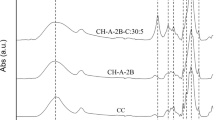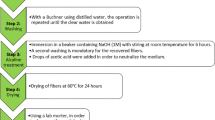Abstract
Biopolymer-based materials from renewable sources are the core target of the researchers in modern time. Following this motivation, we have developed solid polymer electrolytes (SPEs) from empty fruit branch (EFB) of oil palm. The cellulose was extracted from EFB and modified to carboxymethyl cellulose (CMC) by its reaction with monochloroacetic acid in a strongly alkaline medium. The samples were characterized by FTIR, 13C NMR, and XRD to confirm the presence of different functional groups, new connectivity, and crystalline/amorphous nature of the materials, respectively. The CMC-based SPEs were fabricated by blending it with different quantities of lithium iodide (LiI) as dopant. The existence of polymer-salt interactions was revealed by FTIR analysis. The maximum ionic conductivity of 5.58 × 10−3 S cm−1 was observed on sample containing 65 wt% LiI with the lowest activation energy of 0.249 eV.












Similar content being viewed by others
References
Rizwan M, Yahya R, Hassan A, Yar M, Azzahari A, Selvanathan V, Sonsudin F, Abouloula C (2017) pH sensitive hydrogels in drug delivery: brief history, properties, swelling, and release mechanism, material selection and applications. Polymers (Basel) 9:225. https://doi.org/10.3390/polym9060225
Palamae S, Dechatiwongse P, Choorit W, Chisti Y, Prasertsan P (2017) Cellulose and hemicellulose recovery from oil palm empty fruit bunch (EFB) fibers and production of sugars from the fibers. Carbohydr Polym 155:491–497. https://doi.org/10.1016/j.carbpol.2016.09.004
Rachtanapun P, Luangkamin S, Tanprasert K, Suriyatem R (2012) Carboxymethyl cellulose film from durian rind. LWT Foof Sci Technol 48:52–58. https://doi.org/10.1016/j.lwt.2012.02.029
Adinugraha MP, Marseno DW, Haryadi (2005) Synthesis and characterization of sodium carboxymethylcellulose from cavendish banana pseudo stem (Musa cavendishii LAMBERT). Carbohydr Polym 62:164–169. https://doi.org/10.1016/J.CARBPOL.2005.07.019
Arslan N (2007) Flow properties of cellulose and carboxymethyl cellulose from orange peel. J Food Eng 81:187–199. https://doi.org/10.1016/j.jfoodeng.2006.10.022
Pushpamalar V, Langford SJ, Ahmad M, Lim YY (2006) Optimization of reaction conditions for preparing carboxymethyl cellulose from sago waste. Carbohydr Polym 64:312–318. https://doi.org/10.1016/j.carbpol.2005.12.003
Haleem N, Arshad M, Shahid M, Tahir MA (2014) Synthesis of carboxymethyl cellulose from waste of cotton ginning industry. Carbohydr Polym 113:249–255. https://doi.org/10.1016/j.carbpol.2014.07.023
Morais JPS, Rosa MDF, De Souza Filho MDSM et al (2013) Extraction and characterization of nanocellulose structures from raw cotton linter. Carbohydr Polym 91:229–235. https://doi.org/10.1016/j.carbpol.2012.08.010
Fatah IYA, Khalil HPSA, Aziz AA et al (2014) Exploration of a chemo-mechanical technique for the isolation of nanofibrillated cellulosic fiber from oil palm empty fruit bunch as a reinforcing agent in composites materials. Polymers (Basel) 6:2611–2624. https://doi.org/10.3390/polym6102611
Johar N, Ahmad I, Dufresne A (2012) Extraction, preparation and characterization of cellulose fibres and nanocrystals from rice husk. Ind Crop Prod 37:93–99. https://doi.org/10.1016/j.indcrop.2011.12.016
Penjumras P, Rahman RA, Talib RA, Abdan K (2015) Response surface methodology for the optimization of preparation of biocomposites based on poly (lactic acid) and durian peel cellulose. Sci World J 2015:293609. https://doi.org/10.1155/2015/293609
Scurlock JMO, Dayton DC, Hames B (2000) Bamboo: an overlooked biomass resource? Biomass Bioenergy 19:229–244. https://doi.org/10.1016/S0961-9534(00)00038-6
Roy D, Semsarilar M, Guthrie JT, Perrier S (2009) Cellulose modification by polymer grafting: a review. Chem Soc Rev 38:2046–2064. https://doi.org/10.1039/b808639g
Bochek AM (2003) Effect of hydrogen bonding on cellulose solubility in aqueous and nonaqueous solvents. Russ J Appl Chem 76:1711–1719. https://doi.org/10.1023/B:RJAC.0000018669.88546.56
Zhou J, Zhang L (2000) Solubility of cellulose in NaOH/urea aqueous solution. Polym J 32:866–870. https://doi.org/10.1295/polymj.32.866
Hussain PR, Meena RS, Dar MA, Wani AM (2010) Carboxymethyl cellulose coating and low-dose gamma irradiation improves storage quality and shelf life of pear (Pyrus communis L., cv. Bartlett/William). J Food Sci 75:M586–M596. https://doi.org/10.1111/j.1750-3841.2010.01868.x
Chai M, Mohamad Isa MIN (2011) Carboxyl methylcellulose solid polymer electrolytes: ionic conductivity and dielectric study. J Curr Eng Res 1:23–27
Alizadeh Asl S, Mousavi M, Labbafi M (2017) Synthesis and characterization of carboxymethyl cellulose from sugarcane bagasse. J Food Process Technol 8:687. https://doi.org/10.4172/2157-7110.1000687
Bono A, Ying PH, Yan FY et al (2009) Synthesis and characterization of carboxymethyl cellulose from palm kernel cake. Adv Nat Appl Sci 3:5–11
Cheng H, Qian Q, Wang X, Yu P, Mao L (2012) Electricity generation from carboxymethyl cellulose biomass: a new application of enzymatic biofuel cells. Electrochim Acta 82:203–207. https://doi.org/10.1016/J.ELECTACTA.2011.11.122
Moretti A, Kim G-T, Bresser D, Renger K, Paillard E, Marassi R, Winter M, Passerini S (2013) Investigation of different binding agents for nanocrystalline anatase TiO2 anodes and its application in a novel, green lithium-ion battery. J Power Sources 221:419–426. https://doi.org/10.1016/J.JPOWSOUR.2012.07.142
Chen Z, Kim GT, Chao D, Loeffler N, Copley M, Lin J, Shen Z, Passerini S (2017) Toward greener lithium-ion batteries: aqueous binder-based LiNi0.4Co0.2Mn0.4O2cathode material with superior electrochemical performance. J Power Sources 372:180–187. https://doi.org/10.1016/j.jpowsour.2017.10.074
Zolin L, Nair JR, Beneventi D et al (2016) A simple route toward next-gen green energy storage concept by nanofibres-based self-supporting electrodes and a solid polymeric design. Carbon N Y 107:811–822. https://doi.org/10.1016/j.carbon.2016.06.076
Bella F, Nair JR, Gerbaldi C (2013) Towards green, efficient and durable quasi-solid dye-sensitized solar cells integrated with a cellulose-based gel-polymer electrolyte optimized by a chemometric DoE approach. RSC Adv 3:15993. https://doi.org/10.1039/c3ra41267a
Bella F, Pugliese D, Zolin L, Gerbaldi C (2017) Paper-based quasi-solid dye-sensitized solar cells. Electrochim Acta 237:87–93. https://doi.org/10.1016/j.electacta.2017.03.211
Heinze T, Liebert TIM, KLÜFERS P, MEISTER F (1999) Carboxymethylation of cellulose in unconventional media. Cellulose 6:153–165
Heinze T, Koschella A (2005) Solvents applied in the field of cellulose chemistry—a mini review. Polímeros 15:84–90. https://doi.org/10.1590/S0104-14282005000200005
Heinze T, Pfeiffer K (1999) Studies on the synthesis and characterization of carboxymethylcellulose. Die Angew Makromol Chemie 266:37–45. https://doi.org/10.1002/(SICI)1522-9505(19990501)266:1<37::AID-APMC37>3.0.CO;2-Z
Qi H, Liebert T, Meister F, Heinze T (2009) Homogenous carboxymethylation of cellulose in the NaOH / urea aqueous solution. React Funct Polym 69:779–784. https://doi.org/10.1016/j.reactfunctpolym.2009.06.007
Heinze T, Koschella A, Kull AH et al. (2000) Effective preparation of cellulose derivatives in a new simple cellulose solvent. Macromol Chem Phys 201:627–631
Gondaliya N, Kanchan DK, Sharma P (2013) Effect of a plasticizer on a solid polymer electrolyte. Soc Plast Eng:3–6. https://doi.org/10.2417/spepro.004646
Benhamou K, Kaddami H, Magnin A, Dufresne A, Ahmad A (2015) Bio-based polyurethane reinforced with cellulose nanofibers: a comprehensive investigation on the effect of interface. Carbohydr Polym 122:202–211. https://doi.org/10.1016/j.carbpol.2014.12.081
Ahmad NH, Isa MIN (2016) Characterization of un-plasticized and propylene carbonate plasticized carboxymethyl cellulose doped ammonium chloride solid biopolymer electrolytes. Carbohydr Polym 137:426–432. https://doi.org/10.1016/j.carbpol.2015.10.092
Stojanović Ž, Jeremić K, Jovanović S, Lechner MD (2005) A comparison of some methods for the determination of the degree of substitution of carboxymethyl starch. Starch/Staerke 57:79–83. https://doi.org/10.1002/star.200400342
Segal L, Creely JJ, Martin AEJ, Conrad CM (1959) An empirical method for estimating the degree of crystallinity of native cellulose using the X-ray diffractometer. Text Res J 29:786–794. https://doi.org/10.1177/004051755902901003
Bendahou D (2015) Nouveaux matériaux nanoporeux et bio-hybrides à base de nanoparticules minérales et/ou celllulosiques: relation structure / propriétés bio-hybrides à base de nanoparticules minérales et/ou cellulosiques: Relation Structure / Propriétés
Eyler RW, Klug ED, Diephuis F (1947) Determination of degree of substitution of sodium carboxymethylcellulose. Anal Chem 19:24–27. https://doi.org/10.1021/ac60001a007
Morán JI, Alvarez VA, Cyras VP, Vázquez A (2008) Extraction of cellulose and preparation of nanocellulose from sisal fibers. Cellulose 15:149–159. https://doi.org/10.1007/s10570-007-9145-9
Alemdar A, Sain M (2008) Isolation and characterization of nanofibers from agricultural residues—wheat straw and soy hulls. Bioresour Technol 99:1664–1671. https://doi.org/10.1016/j.biortech.2007.04.029
Yang H, Yan R, Chen H, Lee DH, Zheng C (2007) Characteristics of hemicellulose, cellulose and lignin pyrolysis. Fuel 86:1781–1788. https://doi.org/10.1016/j.fuel.2006.12.013
Le Troedec M, Sedan D, Peyratout C et al (2008) Influence of various chemical treatments on the composition and structure of hemp fibres. Compos Part A Appl Sci Manuf 39:514–522. https://doi.org/10.1016/j.compositesa.2007.12.001
Lakshmi DS, Trivedi N, Reddy CRK (2017) Synthesis and characterization of seaweed cellulose derived carboxymethyl cellulose. Carbohydr Polym 157:1604–1610. https://doi.org/10.1016/j.carbpol.2016.11.042
Su’Ait MS, Ahmad A, Badri KH et al (2014) The potential of polyurethane bio-based solid polymer electrolyte for photoelectrochemical cell application. Int J Hydrog Energy 39:3005–3017. https://doi.org/10.1016/j.ijhydene.2013.08.117
Yusuf SNF, Azzahari AD, Yahya R, Majid SR, Careem MA, Arof AK (2016) From crab shell to solar cell: a gel polymer electrolyte based on N-phthaloylchitosan and its application in dye-sensitized solar cells. RSC Adv 6:27714–27724. https://doi.org/10.1039/C6RA04188D
Ahmad Kuthi FA, Haji Badri K, Mohmad Azman A (2015) X-ray diffraction patterns of oil palm empty fruit bunch fibers with varying crystallinity. Adv Mater Res 1087:321–328. https://doi.org/10.4028/www.scientific.net/AMR.1087.321
El-Sayed S, Mahmoud KH, Fatah AA, Hassen A (2011) DSC, TGA and dielectric properties of carboxymethyl cellulose/polyvinyl alcohol blends. Phys B Condens Matter 406:4068–4076. https://doi.org/10.1016/j.physb.2011.07.050
Nishio Y, St. John Manley R (1988) Cellulose/poly(vinyl alcohol) blends prepared from solutions in DMAc-LiCl. Macromolecules 21:1270–1277
Tongdeesoontorn W, Mauer LJ, Wongruong S, Sriburi P, Rachtanapun P (2011) Effect of carboxymethyl cellulose concentration on physical properties of biodegradable cassava starch-based films. Chem Cent J 5:1–8. https://doi.org/10.1186/1752-153X-5-6
Zhang J, Zhao J, Yue L, Wang Q, Chai J, Liu Z, Zhou X, Li H, Guo Y, Cui G, Chen L (2015) Safety-reinforced poly(propylene carbonate)-based all-solid-state polymer electrolyte for ambient-temperature solid polymer lithium batteries. Adv Energy Mater 5:1–10. https://doi.org/10.1002/aenm.201501082
Samsudin AS, Isa MIN (2012) Ion conducting mechanism of carboxy methylcellulose doped with ionic dopant salicylic acid based solid polymer electrolytes 2:113–121
Rani MSA, Rudhziah S, Ahmad A, Mohamed NS (2014) Biopolymer electrolyte based on derivatives of cellulose from kenaf bast fiber. Polymers (Basel) 6:2371–2385. https://doi.org/10.3390/polym6092371
Monisha S, Mathavan T, Selvasekarapandian S, Milton Franklin Benial A, Aristatil G, Mani N, Premalatha M, Vinoth pandi D (2017) Investigation of bio polymer electrolyte based on cellulose acetate-ammonium nitrate for potential use in electrochemical devices. Carbohydr Polym 157:38–47. https://doi.org/10.1016/j.carbpol.2016.09.026
Rudhziah S, Rani MSA, Ahmad A, Mohamed NS, Kaddami H (2015) Potential of blend of kappa-carrageenan and cellulose derivatives for green polymer electrolyte application. Ind Crop Prod 72:133–141. https://doi.org/10.1016/j.indcrop.2014.12.051
Hafiza MN, Isa MIN (2017) Solid polymer electrolyte production from 2-hydroxyethyl cellulose: effect of ammonium nitrate composition on its structural properties. Carbohydr Polym 165:123–131. https://doi.org/10.1016/j.carbpol.2017.02.033
Andrade JR, Raphael E, Pawlicka A (2009) Plasticized pectin-based gel electrolytes. Electrochim Acta 54:6479–6483. https://doi.org/10.1016/j.electacta.2009.05.098
Che Balian SR, Ahmad A, Mohamed NS (2016) The effect of lithium iodide to the properties of carboxymethyl k-carrageenan/carboxymethyl cellulose polymer electrolyte and dye-sensitized solar cell performance. Polymers (Basel) 8:1–10. https://doi.org/10.3390/polym8050163
Selvanathan V, Danial A, Azizah A et al (2017) Ternary natural deep eutectic solvent ( NADES ) infused phthaloyl starch as cost efficient quasi-solid gel polymer electrolyte. Carbohydr Polym 167:210–218. https://doi.org/10.1016/j.carbpol.2017.03.023
Shukur MF, Majid N, Kadir MFZ, Ithnin R (2013) Electrical analysis of amorphous corn starch-based polymer electrolyte membranes doped with LiI. Phys Scr 88:1–9. https://doi.org/10.1088/0031-8949/88/02/025601
Funding
The study was supported by a financial grant from the University of Malaya (FG031-17AFR).
Author information
Authors and Affiliations
Corresponding author
Ethics declarations
Conflict of interest
The authors declare that they have no conflict of interest.
Rights and permissions
About this article
Cite this article
Naceur Abouloula, C., Rizwan, M., Selvanathan, V. et al. A novel application for oil palm empty fruit bunch: extraction and modification of cellulose for solid polymer electrolyte. Ionics 24, 3827–3836 (2018). https://doi.org/10.1007/s11581-018-2558-7
Received:
Revised:
Accepted:
Published:
Issue Date:
DOI: https://doi.org/10.1007/s11581-018-2558-7




